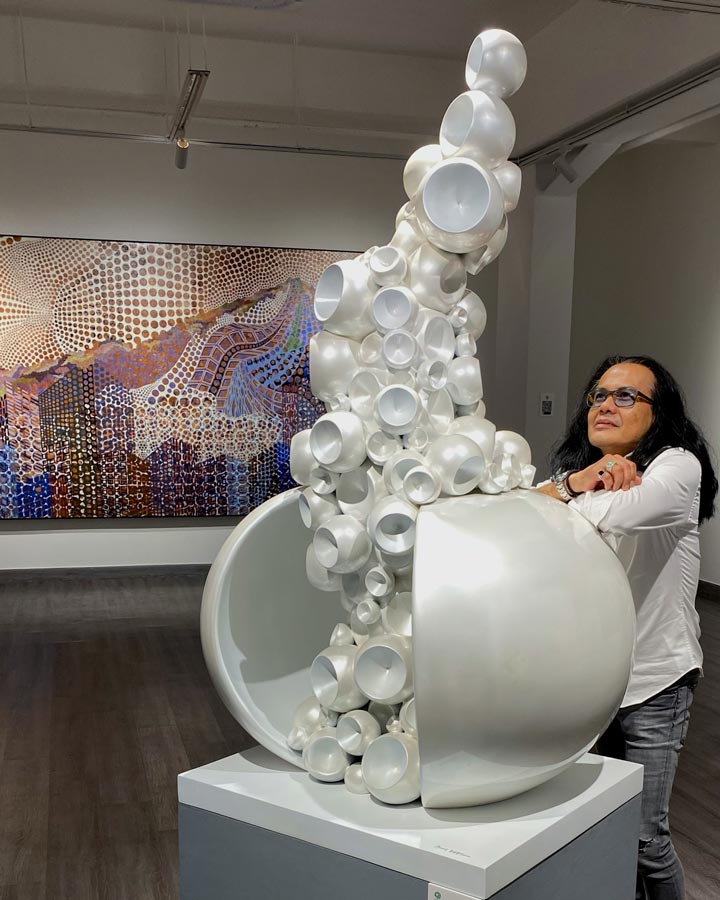
Spirals of vibrant circular geometric designs pulsate from central points. Layers of contrasting structured, repetitious patterns fills the canvas with stunning visual information. While we gaze upon the seemingly unknown vistas of movement with dazzling colour alongside earthy tones, cosmic landscapes and natural elements such as flowers and leaves remind us of home. We engage in a resounding sense of peace and calm.
Awang Behartawan’s fascinating, otherworldly paintings distinguish his creative voice within Indonesian contemporary art. At a glance, they appear abstract, yet he offers us compelling insight into the nature of reality itself.
Imagine if we took a mega-microscopic camera to our environment to capture the mechanisms of dynamic natural systems. Revealed are never-ending, self-repeating patterns that continue in expanding scales known as fractals. Fractal geometric patterns are ubiquitous in the universe, helping us to understand the energetic fabric that contains all life. Eastern philosophy, Western science, math, and art collide in Behartawan’s complex images, also known as Awangart. His creations combine drawing, painting, digital design and photography.
Fractals are found throughout the natural world. In the spiral architecture of a nautilus shell, a flower from the bud to full bloom or a tree, endlessly sprouting shoots that evolve into branches, and the root system of similar design. Awangart is derived from his intuitive voice. Its rhythms follow a mathematical formula, the Mandelbrot Set, demonstrating how the natural world is created. Named after the Polish-born, French and American mathematician Benoit Mandelbrot, who in the late 1970s calculated the equation to express this code, he penned the term ‘Fractal”, often referred to as God’s Creation Code.


Right: Awang Berhartawan and his sculpture ‘Eternally Connected’, as Jagad Galeri – courtesy of Dadi Setiyadi.
Initially, Awang did not know about the Mandelbrot Set and the geometric fabric of the universe until Australian writer Cynthia Webb in 2015 in her curatorial text paraphrased, “Awang does not claim to be a mathematician, but artists unknowingly have some access to this branch of mathematics because they are so sensitive to the visual patterns of nature.”
Born in Palembang, Sumatra, in 1970, educated as a Graphic Designer from Modern School of Design (MSD), Yogyakarta, Awang is an international artist who has resided in Denmark since 1997. He lives in Copenhagen with his family and works between Denmark and his studio in Yogyakarta, Indonesia. Awangart is a meeting of Eastern and Western influences expressed within a global contemporary art visual formula.
“I stand with one leg in European Danish culture and the other in Asian Indonesian culture,” Awang told NOW!Jakarta Magazine. “The batik technique from Sumatra influences dots and leaves motifs, which I sometimes incorporate. Javanese philosophies also influence me; fractals can be referred to as Cakra Manggilingan, which can be translated as the Wheel of Life,” he said and continues, “A huge challenge for me is being able to incorporate these cultures into my work.”
To help comprehend the universe, we must think in terms of cycles, patterns and rhythms. Over time and through his association with others, Awang understood that his art was a fusion of the macro and microcosmic representation of human experience. His ideas are a metaphor for the past, present, and future and the repetitious nature of life. “When I look into my son’s eyes, I see repetition. That I live on, even when I’m not here anymore,” Awang said about his role as a father. “Repeating patterns are seen in how people go about their day-to-day routines for survival.”

I asked Awang about audience responses to his work, especially those without knowledge about his themes. “People are amazed by the details and precision and because of the movement in my paintings. They sometimes think the compositions are printed on a computer. They understand and often smile upon my explanation of fractals because these aspects of life have occurred and they had not realised or thought about.”
Highly prolific Awang has showcased his work consistently for nearly three decades. He has exhibited in Singapore, Malaysia, South Korea, Hong Kong, Japan, Czechoslovakia, Sweden, Germany, Indonesia, and Denmark regularly. His latest solo exhibition, RETURN at Jagad Gallery in Jakarta, opened on 27 January and recently closed on 27 February 2024 and featured one 3-dimensional fibreglass sculpture and eighteen paintings ranging in size up 4m by 2m.
What sets the artists apart is their sensitivity and ability to absorb intelligence from the world they observe. Attuning with the supernatural forces and creative potential, they translate invisible energy into form; the metaphysical unites with physical dimensions. Awangart prompts us to be aware of the bigger picture. His paintings inspire enquiry and unity consciousness and for us to engage more deeply in the astonishing natural environment we are not separate from but a part of.






